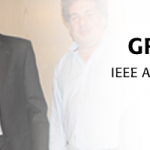Adapting SAVE Vaccine Technology for COVID-19
[*Note: IEEE Entrepreneurship attended the AUTM 2022 Annual Meeting in New Orleans as it aligns with the IEEE Entrepreneurship Vision Statement – Connecting tech entrepreneurs to an engineering-driven global innovation network.
AUTM’s Annual Meeting is the place for global technology transfer professionals to meet and gain insights from global speakers, be inspired, and reinvigorate their own professional development.
IEEE Entrepreneurship is honored to endorse innovative initiatives and organizations that promote strong themes that are connected to the mission to foster entrepreneurial engineering and technological innovation for the benefit of humanity like the Association of University Tech Transfer Managers (AUTM) and their Better World Project (BWP).
The following engineering success story features one of the BWP Stories.]
Codagenix, a spinoff from Stony Brook University (SBU) in Stony Brook, NY, used its existing rapid vaccine development process to successfully synthesize a readily scalable live-attenuated vaccine candidate against COVID-19.
Starting from only viral sequence data, using its Synthetic Attenuated Virus Engineering (SAVE) technology, Codagenix can design, construct, and grow multiple live-attenuated vaccine candidates ready for animal safety and efficacy testing in less than one month.
Seeking to tackle today’s most challenging issue, Codagenix partnered with vaccine manufacturer Serum Institute of India to develop a live-attenuated vaccine for COVID-19. CodaVax-COVID-19, a single-dose intranasal vaccine, yielded positive results in an animal study and the companies are planning human trials, slated to begin at the end of 2020.
SAVE uses computer algorithms to design viral genomes that are inefficiently translated into proteins by the virus in human cells. The in-silico-designed genomes are then chemically synthesized from scratch and introduced into cells to produce weakened viruses. The protein sequence of the original circulating virus is maintained. However, the inefficiency in translation reduces the virus’s ability to replicate and cause disease, enabling it to be used as a live attenuated vaccine.
Codagenix was born in the laboratory of National Academy of Science Member and SBU Distinguished Professor Eckard Wimmer, who was the first to synthesize a virus from scratch. The discovery opened the door to redesigning viral genomes to turn viruses into effective preventive vaccines and immunotherapies. SBU began investing in the SAVE patent portfolio in 2007.
“Codagenix is a shining example of what can happen when you mix great translational science and entrepreneurial faculty in a supportive and nurturing innovation ecosystem. Their story is truly an inspiration to those who are considering starting a new venture or engaging in the process to bring their inventions to the market,” said Sean Boykevisch, Director of SBU’s Office of Technology Licensing and Industry Relations (OTLIR).
Inspired by the promise of SAVE, Steffen Mueller incorporated Codagenix while participating in a 2009 Business Boot Camp Workshop organized by the Center for Biotechnology (A New York State Center for Advanced Technology located on SBU’s campus) in collaboration with SBU’s OTLIR. The company was formalized with Wimmer, Mueller, and J. Robert Coleman (both of whom received their PhDs in Wimmer’s lab) as founders after the team received Small Business Technology Transfer funding in 2011.
 Public funding from the NIH Small Business Innovation Research grant program and the U.S. Department of Agriculture, which was interested in the technology for animal vaccinations, supported Codagenix until it attracted its first private investor in 2012. The US$4.25m investment from venture capital firm Topspin Partners enabled Codagenix to bring its influenza vaccine into clinical trials in Australia and its Respiratory Syncytial Virus (RSV), Zika, and Dengue vaccines to the preclinical stage.
Public funding from the NIH Small Business Innovation Research grant program and the U.S. Department of Agriculture, which was interested in the technology for animal vaccinations, supported Codagenix until it attracted its first private investor in 2012. The US$4.25m investment from venture capital firm Topspin Partners enabled Codagenix to bring its influenza vaccine into clinical trials in Australia and its Respiratory Syncytial Virus (RSV), Zika, and Dengue vaccines to the preclinical stage.
Codagenix closed a US$20 million Series B funding round in 2019 to fund the clinical development of the RSV vaccine and a broadly protective influenza vaccine, both of which are in clinical trials. The company is also exploring using its platform technology to turn viruses into oncolytic immuno-oncology therapies.
“We are grateful to our investors and partners like the Center for Biotechnology that understand our vision and continually support our development at these early stages. We are demonstrating that our platform provides a rational means to design vaccines against a range of targets – yielding candidates suitable for full clinical development,” Coleman said.
SBU played an essential role in the success of SAVE. Beginning in 2007, SBU’s Office of Technology Licensing and Industry Relations (OTLIR) invested in developing SAVE technology’s patent portfolio. OTLIR continued to support and grow the portfolio while Codagenix got off the ground. The licensed portfolio consists of three patent families filed internationally. After receiving STTR funding, Codagenix moved into the SBU’s business incubator, Long Island High Technology Incubator (LIHTI), adjacent to the Stony Brook campus, and executed an option agreement with the OTLIR in 2013 and a license agreement in 2016. Since then, the company has received a significant number of additional grants and VC investments fueling its rapid growth.
“Codagenix is an incredible example of a company rooting in our expanding bio ecosystem, growing from a startup out of Stony Brook University into a clinical-stage company,” said Dr. Clinton Rubin, Director of the New York State Center for Biotechnology at Stony Brook University. “The Center for Biotechnology is proud to provide ongoing support for the work they are doing through our various programs including the Applied Research and Development awards and the Long Island Bioscience Hub funding initiatives.”
This story was originally published in 2020.
To see available technologies from research institutions, click here to visit the AUTM Innovation Marketplace.
Go to AUTM to read the complete article.
About the Better World Project
Technology transfer, the process of moving an idea from an academic lab to the marketplace, can be difficult to understand for those outside research.
That’s why AUTM came up with the Better World Project (BWP) more than a decade ago, to illustrate the impacts of research commercialization on the world by sharing its successes.
Whether explaining the genesis of the Honeycrisp apple, or the founding of Google, these stories not only showcase the value of the technologies and their applications around the world, but also the important steps that build tech transfer success. There are examples of unique funding obtained by researchers, key collaborations with industry, and the many contributions of tech transfer offices that have helped bring the research to life.
Today, Better World’s searchable database includes more than 450 stories and videos. Have a look.






